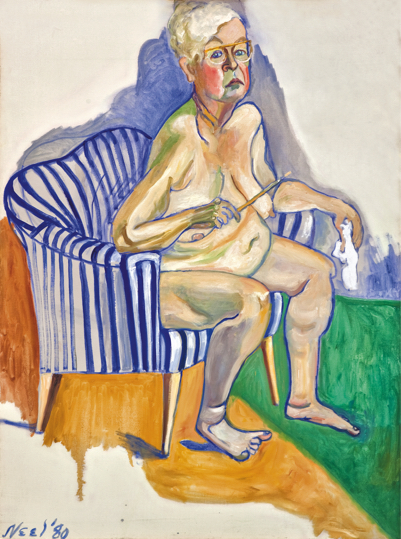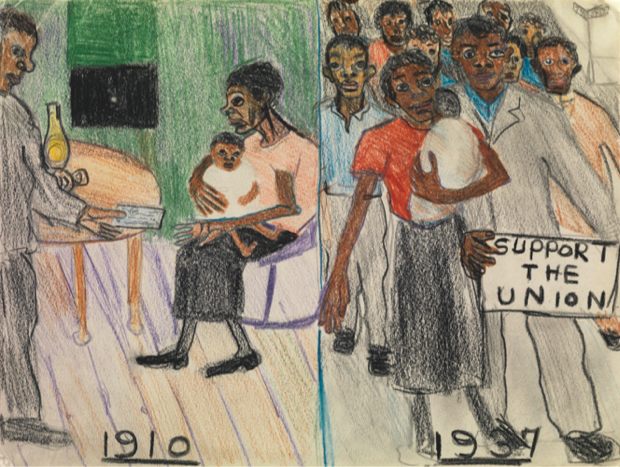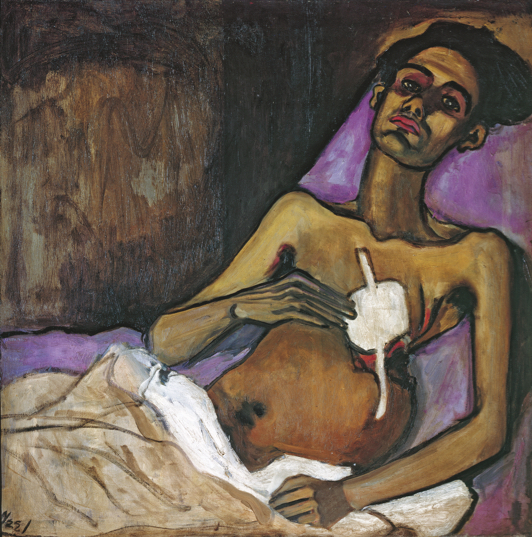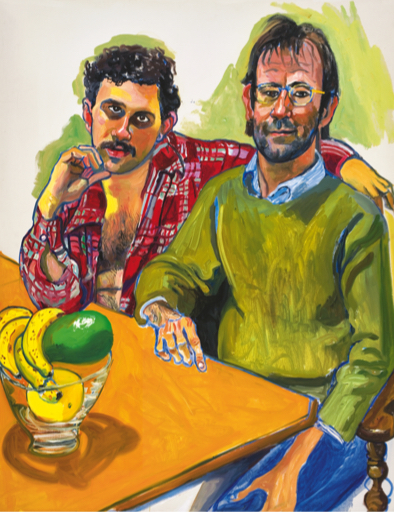Alice Neel: Hot Off The Griddle, Barbican review ★★★★★
Alice Neel, Pregnant Julie and Algis © The Estate of Alice Neel. Courtesy of The Estate of Alice Neel
It is impossible to come face to face with an Alice Neel portrait and just move on. Her subjects summon the viewer. Depicted is much more than their outer appearance: it’s the artist’s probing of their inner selves.
In Pregnant Julie and Algis, pictured above, there is a tension in the angle of her head to match the disquiet in her eyes. There is a story there, much deeper than the surface image of a seemingly relaxed expectant couple. You stand before it and wonder.
Or take Neel’s own self-portrait, which she didn't come round to painting until she was 80 years old.

She paints it as it is, her sharp alert gaze contrasting with the uncompromising depiction of her sagging flesh and swollen ankles, her paintbrush evident in the foreground defining her.
Like all her subjects, Neel is portrayed, in her own words, ‘right off the griddle’, catching life as it goes by.
Alice Neel (1900–1984) was born in a small town in Pennsylvania, studied art in Philadelphia, and lived most of her life in New York, with a stint in Havana following her 1925 marriage to the Cuban avantgarde artist Carlos Enríquez Gómez.
Her life wasn’t easy, and she was never well off, but she knew what she wanted, having discovered in herself the qualities needed to be a good artist: ‘hypersensitivity and the will of the devil.’
Relentlessly focused on people and human dignity, she described herself as ‘an anarchic humanist’, while the FBI, which kept an eye on her as a member of the Communist Party, described her rather dismissively as ‘a romantic, Bohemian-type communist.’

She painted the poverty and squalor of Harlem where she lived in the 1930s and 40s, and which she described as ‘a battlefield of humanism’, her painting TB Harlem testament to the brutal treatment of the raging tuberculosis epidemic there.

The 1940s ushered in abstraction, which became the dominant mode of artistic expression, something which Alice Neel always resisted. As she herself put it: ‘I’m not against abstraction. Do you know what I’m against? Saying Man himself has no importance.’
Neel’s focus on figurative painting accounts for the relative obscurity in which her work fell; the exhibition Alice Neel: Hot Off The Griddle, organised in collaboration with the Centre Pompidou, Paris, offers an unmissable opportunity to re-assess her position within the art world.
For the importance of her political work, what follows you once you leave the Barbican Gallery is the urge to solve the riddles and answer the questions posed by her portraits.

In her later years Alice Neel became famous for her lectures, and the documentary film by Nancy Baer, which brings the exhibition to a close, allows us a glimpse of the flesh-and-blood Alice Neel, and lets her speak for herself about life and its place in her art.
In Pregnant Julie and Algis, pictured above, there is a tension in the angle of her head to match the disquiet in her eyes. There is a story there, much deeper than the surface image of a seemingly relaxed expectant couple. You stand before it and wonder.
Or take Neel’s own self-portrait, which she didn't come round to painting until she was 80 years old.

Alice Neel, Self-Portrait 1980 © The Estate of Alice Neel. Courtesy of The Estate of Alice Neel
She paints it as it is, her sharp alert gaze contrasting with the uncompromising depiction of her sagging flesh and swollen ankles, her paintbrush evident in the foreground defining her.
Like all her subjects, Neel is portrayed, in her own words, ‘right off the griddle’, catching life as it goes by.
Alice Neel (1900–1984) was born in a small town in Pennsylvania, studied art in Philadelphia, and lived most of her life in New York, with a stint in Havana following her 1925 marriage to the Cuban avantgarde artist Carlos Enríquez Gómez.
Her life wasn’t easy, and she was never well off, but she knew what she wanted, having discovered in herself the qualities needed to be a good artist: ‘hypersensitivity and the will of the devil.’
Relentlessly focused on people and human dignity, she described herself as ‘an anarchic humanist’, while the FBI, which kept an eye on her as a member of the Communist Party, described her rather dismissively as ‘a romantic, Bohemian-type communist.’

Alice Neel, Support the Union 1937. © The Estate of Alice Neel. Courtesy of The Estate of Alice Neel
She painted the poverty and squalor of Harlem where she lived in the 1930s and 40s, and which she described as ‘a battlefield of humanism’, her painting TB Harlem testament to the brutal treatment of the raging tuberculosis epidemic there.

Alice Neel, T.B. Harlem 1940 © The Estate of Alice Neel. Courtesy of The Estate of Alice Neel
The 1940s ushered in abstraction, which became the dominant mode of artistic expression, something which Alice Neel always resisted. As she herself put it: ‘I’m not against abstraction. Do you know what I’m against? Saying Man himself has no importance.’
Neel’s focus on figurative painting accounts for the relative obscurity in which her work fell; the exhibition Alice Neel: Hot Off The Griddle, organised in collaboration with the Centre Pompidou, Paris, offers an unmissable opportunity to re-assess her position within the art world.
For the importance of her political work, what follows you once you leave the Barbican Gallery is the urge to solve the riddles and answer the questions posed by her portraits.

Alice Neel, Geoffrey Hendricks and Brian © The Estate of Alice Neel. Courtesy The Estate of Alice Neel
In her later years Alice Neel became famous for her lectures, and the documentary film by Nancy Baer, which brings the exhibition to a close, allows us a glimpse of the flesh-and-blood Alice Neel, and lets her speak for herself about life and its place in her art.
TRY CULTURE WHISPER
Receive free tickets & insider tips to unlock the best of London — direct to your inbox
| What | Alice Neel: Hot Off The Griddle, Barbican review |
| Where | Barbican Centre, Silk Street, London, EC2Y 8DS | MAP |
| Nearest tube | Barbican (underground) |
| When |
16 Feb 23 – 21 May 23, Open 10:00 to 17:00 Thu & Fri 10:00 to 19:00 |
| Price | £18 (concessions available) |
| Website | Click here to book |